December Birth Flowers
Birth flowers, also known as birthday flowers or month flowers , are a delightful tradition that assigns specific flowers to each month of the year. These flowers are believed to bring luck, happiness, and positive energy to individuals born in their respective months. By gifting or incorporating your birth flower into your life, you can connect with the unique traits and symbolism associated with it.
December is a month filled with festive celebrations and joy, and what better way to embrace the spirit of this month than by exploring the beautiful birth flowers it has to offer? In this blog post, we will delve into the enchanting world of December birth flowers: Narcissus, Poinsettia, and Holly.
In this blog post, we will take a closer look at these December birth flowers, exploring their origins, symbolism, various types, care tips, intriguing facts, and how they play a significant role in December celebrations.
Narcissus
Narcissus, the first of our December birth flowers, is a charming and symbolic bloom with a fascinating history. Let’s explore the origins, various types, care tips, and some intriguing facts about this beautiful flower.
Origin and Symbolism
Narcissus, also known as the daffodil, traces its roots back to Greek mythology. It gets its name from the character Narcissus, a handsome youth who, according to legend, became so infatuated with his reflection in a pool of water that he eventually transformed into a flower. This captivating tale of self-love and transformation has given the Narcissus a profound symbolism of rebirth and renewal.
In various cultures, the Narcissus is associated with different meanings. In general, it represents hope, optimism, and the promise of new beginnings—a fitting sentiment as we welcome the new year in December.
Types of Narcissus
Narcissus is a diverse genus with a wide array of species and cultivated varieties, each showcasing its unique beauty. Here are a few notable types:
- Daffodils: Perhaps the most well-known, daffodils feature vibrant yellow or white petals surrounding a trumpet-shaped central corona.
- Paperwhite Narcissus: These dainty, fragrant flowers are a popular choice for indoor forcing, often gracing homes during the winter months.
- Tazetta Narcissus: Characterized by clusters of small, fragrant flowers on each stem, Tazetta Narcissus adds a touch of elegance to gardens and floral arrangements.
- Cyclamineus Narcissus: With petals swept back like windswept hair, this type has a distinct and graceful appearance.
Care Tips
To ensure the longevity and beauty of Narcissus blooms, it’s essential to provide them with proper care, whether you’re growing them in your garden or using them in floral arrangements:
- Planting: Plant Narcissus bulbs in well-draining soil in the fall, ideally a few weeks before the first frost.
- Sunlight: Place them in a sunny spot where they can receive at least 6 hours of sunlight per day.
- Watering: Keep the soil consistently moist but not waterlogged. Narcissus prefers slightly damp conditions.
- Fertilization: Apply a balanced fertilizer in the spring when the leaves begin to emerge.
- Pruning: After the blooms have faded, allow the foliage to die back naturally. This allows the plant to store energy for the following year’s growth.
When using Narcissus as cut flowers, follow these additional care tips:
- Cutting: Make clean diagonal cuts on the stems with a sharp knife or scissors to prevent stem crushing.
- Water: Change the vase water every few days to prevent bacterial growth and enhance the longevity of the flowers.
Interesting Facts
Narcissus holds a few intriguing secrets that add to its allure:
- Fragrance: Many Narcissus varieties are highly fragrant and emit a sweet, captivating scent that can fill an entire room.
- Symbol of Spring: In various cultures, Narcissus is considered a harbinger of spring. Its appearance in gardens often marks the end of winter and the arrival of warmer days.
- Poetry and Art: Throughout history, Narcissus has been a subject of fascination for poets and artists, who often draw inspiration from its unique form and symbolism.
Poinsettia

Poinsettia , with its vibrant red and green foliage, is an iconic December birth flower that is synonymous with the holiday season. Let’s dive into the fascinating history, the various varieties, care tips, and some fun facts about this beloved December bloom.
Origin and Symbolism
Poinsettia, scientifically known as Euphorbia pulcherrima, is native to Mexico and was introduced to the United States in the early 19th century by Joel Poinsett, the first U.S. ambassador to Mexico. Its name pays homage to this passionate botanist.
The vibrant red colour of Poinsettias, often associated with Christmas, symbolizes love and the blood of Christ in the Christian tradition. As a result, Poinsettias have become an integral part of holiday decorations and celebrations worldwide, representing the spirit of love and goodwill.
Varieties of Poinsettias
Poinsettias come in various colours beyond the classic red, including white, pink, and even multicoloured varieties. Each type offers a unique and enchanting aesthetic, allowing you to choose the perfect shade to complement your holiday decor.
Care Tips
To ensure your Poinsettia remains vibrant throughout the holiday season, it’s essential to provide proper care:
- Light: Place your Poinsettia in a bright, indirect light location, avoiding direct sunlight.
- Watering: Water the plant when the top inch of soil feels dry to the touch. Be cautious not to overwater, as Poinsettias are sensitive to waterlogged roots.
- Temperature: Poinsettias thrive in temperatures between 65-75°F (18-24°C) during the day and slightly cooler at night.
- Humidity: Maintain moderate humidity levels around the plant to prevent drying out.
- Pruning: After the holiday season, you can prune your Poinsettia to encourage bushiness. Cut back the stems to about 6 inches, leaving 3-4 leaves on each stem.
Fun Facts
Poinsettias have several interesting aspects that make them even more enchanting:
- Modified Leaves: The colourful parts of the Poinsettia that are often mistaken for petals are modified leaves called bracts. The tiny yellow structures in the centre are the true flowers.
- Festival of Lights: In Mexico, Poinsettias are known as “Flores de Noche Buena,” which translates to “Flowers of the Holy Night.” They are a significant part of the Mexican Christmas tradition and the Festival of Lights (La Noche Buena), celebrated on Christmas Eve.
- Good Cheer and Success: Poinsettias are considered a symbol of good cheer and success. Gifting a Poinsettia is seen as a gesture of spreading happiness and best wishes.
- Versatile Decor: Poinsettias aren’t limited to just potted plants. They can be incorporated into various holiday-themed arrangements, such as wreaths, centrepieces, and garlands, adding a touch of elegance to your festive decor.
Holly
Holly, with its glossy green leaves and bright red berries, is a quintessential symbol of the holiday season and one of the December birth flowers. Let’s delve into the historical and symbolic significance, the various types of Holly, its use in holiday decorations, and its traditional medicinal uses.
Origin and Symbolism
Holly has a rich history that predates Christianity. In Roman times, it was associated with the festival of Saturnalia, a celebration of the god Saturn, during the winter solstice. Later, early Christians adopted Holly as a symbol of Christ’s crown of thorns, turning its prickly leaves and red berries into representations of protection, goodwill, and hope.
The evergreen nature of Holly also signifies eternal life, making it a fitting decoration for the season of rebirth and renewal that December represents.
Types of Holly
There are various species of Holly, each with its distinct characteristics. Some common types of Holly include:
- American Holly (Ilex opaca): Known for its classic spiky leaves and bright red berries, it’s a popular choice for holiday decorations.
- English Holly (Ilex aquifolium): Similar to the American Holly but with slightly smaller leaves, it’s native to Europe and widely used in holiday greenery.
- Japanese Holly (Ilex crenata): This species is characterized by its small, compact leaves and is often used in landscaping and ornamental gardens.
Holiday Decorations
Holly plays a central role in holiday decorations, both indoors and outdoors. Its vibrant red berries and glossy green leaves are used in various ways to bring festive cheer:
- Wreaths: Holly wreaths, often adorned with a red bow, are hung on doors as a welcoming symbol and a reminder of the season’s joy.
- Garlands: Holly garlands, sometimes intertwined with other evergreens, are used to decorate banisters, mantels, and windows, adding a touch of nature’s beauty to the home.
- Centrepieces: Holly sprigs and branches are often used in floral arrangements and centrepieces, providing a pop of colour and a connection to nature during holiday feasts.
Medicinal Uses
Beyond its decorative role, Holly has a history of traditional medicinal applications:
- Fever Reduction: In traditional herbal medicine, Holly leaves were used as a remedy to reduce fever and inflammation.
- Colds and Coughs: Infusions made from Holly leaves were believed to help alleviate symptoms of colds and coughs.
- Protection: Holly was sometimes hung in homes as a protective charm, believed to ward off evil spirits and negative energy.
Conclusion
In the embrace of December’s chill and the warmth of holiday celebrations, the December birth flowers, Narcissus, Poinsettia, and Holly, stand as timeless symbols of beauty and meaning. These blooms, steeped in history and adorned with symbolism, offer us a unique opportunity to connect with the essence of this magical month.
So, whether you’re planning a birthday surprise or simply seeking to enhance your holiday décor, consider the elegance and significance of these December birth flowers. To make your celebrations even more memorable, why not order a stunning bouquet from Bourkes Florist ? Let us deliver these natural wonders to your doorstep, adding a touch of enchantment to your December festivities. Order today and let the spirit of December bloom in your life.
FAQs
Q: What are birth flowers, and why are they significant?
Birth flowers are specific flowers associated with each month of the year. They are significant because they hold special symbolism and are believed to bring luck and positive energy to individuals born in their respective months. They offer a unique and personal way to celebrate birthdays and connect with the qualities represented by the flowers.
Q: Can I grow Narcissus, Poinsettia, and Holly in my garden?
Yes, you can grow Narcissus, Poinsettia, and Holly in your garden, depending on your climate and gardening conditions. Narcissus and Poinsettia are typically grown as annuals, while Holly is an evergreen shrub or tree. It’s important to research the specific care requirements for each plant and ensure they are suitable for your region.
Q: Are there any other flowers associated with December birthdays?
Yes, besides Narcissus, Poinsettia, and Holly, some other flowers are occasionally associated with December birthdays. These may include Snowdrops and Camellias, which also bloom during the winter months and carry their unique symbolism and charm.























